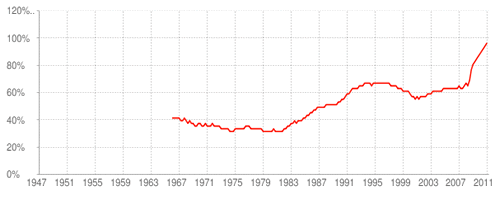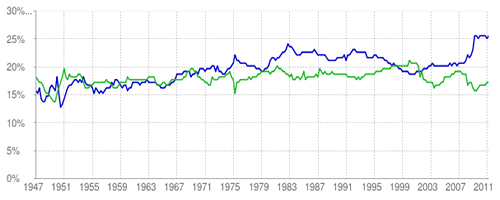There was plenty of discussion on simplifying the US budget to household-sized numbers, and I have nothing to add, because I have zero interest in being an economist. 🙂 Here’s one more attempt at sharing some digestible information. An interesting site called Department of Numbers has collated numbers from government sources like the Treasury and put them together nicely into a series of charts. Here are two I wanted to point out and also save as a historical snapshot of “what things in 2011 looked like”.
US Government Debt as Percentage of GDP

US Government Income and Expenses as Percentage of GDP

From the top chart, you can see that we are close to a 100% debt-to-GDP ratio. The last time it was this high was World War II. Even in recent “good times” – or at least better times than now – the percentage hasn’t really gone down much. That’s what I mean by “kicking the can down the road”. In the bottom chart, you can see the large gap between government revenue generated (taxes) and expenditures.
I’ll go back to saving 50%+ of my income now, hopefully investing it wisely, and not reading scary bedtime stories like Boomerang!
 The Best Credit Card Bonus Offers – 2025
The Best Credit Card Bonus Offers – 2025 Big List of Free Stocks from Brokerage Apps
Big List of Free Stocks from Brokerage Apps Best Interest Rates on Cash - 2025
Best Interest Rates on Cash - 2025 Free Credit Scores x 3 + Free Credit Monitoring
Free Credit Scores x 3 + Free Credit Monitoring Best No Fee 0% APR Balance Transfer Offers
Best No Fee 0% APR Balance Transfer Offers Little-Known Cellular Data Plans That Can Save Big Money
Little-Known Cellular Data Plans That Can Save Big Money How To Haggle Your Cable or Direct TV Bill
How To Haggle Your Cable or Direct TV Bill Big List of Free Consumer Data Reports (Credit, Rent, Work)
Big List of Free Consumer Data Reports (Credit, Rent, Work)
Indeed. And WWII was the last time we were trying to pull the economy out of a hole this deep. Government needs to be more disciplined in the “good times” you cite. That’s not the time to expand spending and cut taxes. Now is.
After WWII the debt/GDP was well above 100% and much higher than it is now. Also a much higher % of the debt in WWII was owned by the public at large versus today when a large % of the debt is owed by the government to itself (mostly social security trust).
See: http://www.usgovernmentspending.com/federal_debt_chart.html
Agreed the last time we were in this financial situation was the Great Depression. The problem above is that during Bush’s term the government acquired debt to finance wars, medicare prescription drugs and tax cuts driving up the debt. At the same time interest rates were cut over stimulating the economy. This was not debt acquired to build up infrastructure at home. We have now entered the Great Recession and are saddled with debt from the good times, which is preventing the Government from doing what it needs to do to restart the economy.
If the Occupy Wall Street goons have their way, the only “safe” investment will be your mattress. At best, we’ll have a stock market malaise like we had in the 1960s and 1970s.
Time of death for civil discourse about an important issue, 10/18 11:43am EDT….